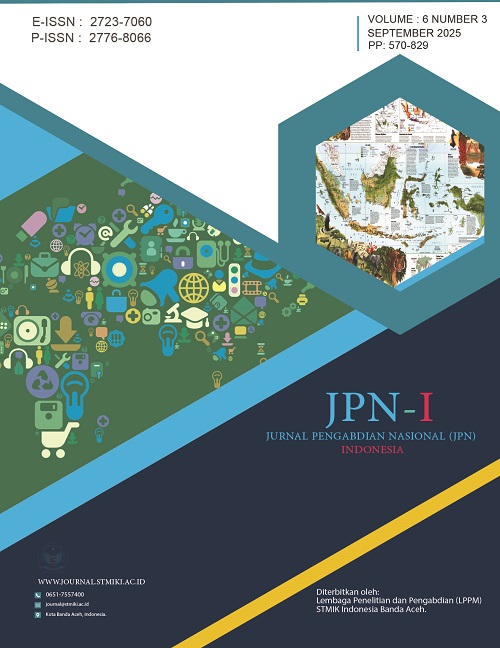Peningkatan Kapasitas Bisnis Berbasis Komunitas dan Mitigasi Sampah melalui Produk Konversi pada Bank Sampah Sinar Berlian
Main Article Content
Abstract
Article Summary
This community service was carried out in Gedog Village, Blitar City. The purpose of the service was to increase the capacity of household waste management and waste mitigation through conversion products and community-based business management at the "Sinar Berlian" Waste Bank in Blitar City. This activity was motivated by the high volume of inorganic waste at the Sinar Berlian Waste Bank and its surroundings and the low participation of residents in waste management. Therefore, through this service, the PKM program was provided to provide solutions to existing problems. The methods used included program socialization, community-based production and management training, technical assistance, and marketing digitalization. The main activities included training in making pressed plastic, sorting plastic waste, community-based management, and digital-based marketing. The final results of this service activity showed that this activity successfully reached a total of 72 active participants, with a predominance of women (68%). The attendance rate reached 85%, indicating the enthusiasm and commitment of participants in absorbing the training materials. In the production sector, the production volume of pressed plastic increased 300%, 1000kg per month up to 3000 kg per month. Income increased by 84.37% compared to before the intervention. Community-based management has succeeded in coordinating 6 other Waste Banks in increasing their production capacity and income. Collaboration was implemented in the form of logistics sharing, namely the acquisition of used plastic bottles and the aggregation of press plastic sales. Participants' understanding was evaluated through pre- and post-tests, which showed an increase in scores from 46% to 82%. This demonstrates the effectiveness of the PRA training method and approach in delivering material in a practical and applicable manner. This program contributes to community-based sustainable environmental management practices and can be replicated in other areas with similar issues.
Downloads
Article Details

This work is licensed under a Creative Commons Attribution-NonCommercial-ShareAlike 4.0 International License.
References
Fandira, W., Solistiyowati, M., & Sibuea, T. (2023, December). Circular Economy: Strategi Utama Dukung Sustainable Development Goals (SDGs) guna Mencapai Tujuan Pembangunan Berkelanjutan. In Prosiding Seminar Nasional Ekonomi dan Perpajakan (Vol. 3, No. 1, pp. 44-54).
Halog, A., & Anieke, S. (2021). A review of circular economy studies in developed countries and its potential adoption in developing countries. Circular Economy and Sustainability, 1(1), 209-230.
Lee, B. X., Kjaerulf, F., Turner, S., Cohen, L., Donnelly, P. D., Muggah, R., ... & Gilligan, J. (2016). Transforming our world: implementing the 2030 agenda through sustainable development goal indicators. Journal of public health policy, 37(Suppl 1), 13-31.
Macarthur, E. L. L. E. N., & Heading, H. E. A. D. I. N. G. (2019). How the circular economy tackles climate change. Ellen MacArthur Found, 1, 1-71.
Medina, M. (2010). Solid wastes, poverty and the environment in developing country cities: Challenges and opportunities (No. 2010/23). WIDER Working Paper.
Meidiana, C., & Gamse, T. (2010). Development of waste management practices in Indonesia. European journal of scientific research, 40(2), 199-210.
Muhsin, A., Nafisah, L., & Siswanti, Y. (2018). Participatory rural appraisal (PRA) for corporate social responsibility (CSR).
Organisation for Economic Co-operation and Development. (2020). The circular economy in cities and regions: Synthesis report. OECD Publishing.
Putra, W. T. (2020). Pemberdayaan masyarakat melalui pengelolaan sampah di bank sampah. Jambura Journal of Community Empowerment, 69-78. https://doi.org/10.37411/jjce.v1i2.569.
Ram, M., & Bracci, E. (2024). Waste management, waste indicators and the relationship with sustainable development goals (SDGs): a systematic literature review. Sustainability, 16(19), 8486.
Sudiyono, R. N., Gazali, G., Radita, F. R., Fitri, A., Johan, M., Pebrina, E. T., ... & Hartati, R. (2024). Pelatihan dan Pendampingan Digital Marketing Bagi Usaha Kecil dan Menengah Serta Penyerahan Bantuan Teknik Bank Sampah di Bumdes Serdang Tirta Kencana. Niswantara: Jurnal Pengabdian Kepada Masyarakat, 1(01), 35-43. https://doi.org/10.70508/f81av542.
Sugianto, S. (2024). Dampak Kebijakan Pemerintah dalam Mendorong Green Economy Berbasis Bank Sampah Terhadap Tingkat Pendapatan Masyarakat Di Indonesia. Journal of Economics, Management, Business, and Entrepreneurship, 2(2), 1-11. https://doi.org/10.31537/jembe.v1i2.2169.
Taufik, D., & Hanafiah, N. (2021). Autovat: an automated visual acuity test using spoken digit recognition with MEL frequency cepstral coefficients and convolutional neural network. Procedia Computer Science, 179, 458-467. https://doi.org/10.1016/j.procs.2021.01.029.
Waluyo, & Kharisma, D. B. (2023). Circular economy and food waste problems in Indonesia: Lessons from the policies of leading Countries. Cogent Social Sciences, 9(1), 2202938. https://doi.org/10.1080/23311886.2023.2202938.
Wang, X., Wei, Y., & Shao, Q. (2020). Decomposing the decoupling of CO2 emissions and economic growth in China’s iron and steel industry. Resources, Conservation and Recycling, 152, 104509. https://doi.org/10.1016/j.resconrec.2019.104509.

